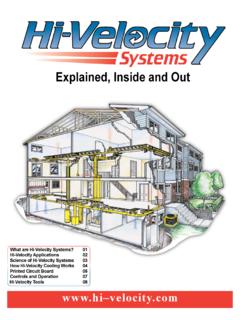Transcription of Tips for Laying Out a New Warehouse - Distribution Team
1 Tips for Laying Out a New Warehouse By Jason Bader Managing Partner The Distribution Team If you are like many of my Distribution clients, you would love to change the layout of your Warehouse to make it more efficient. Unfortunately, creating wholesale change in the facility would be too expensive and disruptive to your current business. You tweak what you can and ponder what could be. What if you had the opportunity to start fresh? What would you do differently? Recently a client sent me a note asking for some advice. He is moving into a new facility and would like to give the Warehouse folks the best opportunity for success.
2 Rather than just send him a note with a few suggestions, I thought it would be appropriate to share it with all my readers. I am sure that you can come up with more ideas, but these should give everyone plenty to consider. Supersize the Receiving Area When my partner Scott and I used to help clients design a new Warehouse , the first thing we would do is draw up an obnoxious amount of space for the receiving function. We knew full well that the client was going to cut it down and throw up more product racks, but we wanted to stress the importance of the space. Receiving is the most critical function in the Warehouse . One mistake here generally translates to ten additional errors before you get it corrected.
3 Let me take a moment to translate. An error in Distribution means a reduction to your net profit. Think about all the activities that a receiving team must do. They break down pallets. They count the items and reconcile with the manufacturer s packing list. Sometimes they add bar-coded labels. Occasionally, the manufacturer makes a shipping error and the team needs to stage the product. Items come in to fulfill customer back orders. We need a place to accommodate this type of cross docking activity. When we force the team to work in cramped quarters, mistakes will occur. Keep Shipping and Receiving Separate Just like in receiving, this function needs to be given adequate space.
4 Take a look at some of the functions in shipping. We often have a double check system. We may be building pallets for common carrier shipment. We may have to prepare small packages for UPS or Fed Ex. If we are using our own vehicles to deliver product, we need to have staging areas for each delivery run. When we try to combine the space, using only one computer terminal, the processes become really confused. Confusion leads to errors in the Warehouse . Please see definition above. Ideally, shipping and receiving would be set up at separate end of the facility. Create a Dead Stock Graveyard This is one of the parts of a perpetual dead stock management plan.
5 Many of us have a difficult time addressing out dead stock problem because it is carefully hidden amongst the living breathing inventory. Out of sight, out of mind. I suggest that you designate an area where your entire dead inventory resides. When you are actively liquidating this inventory, it is much more satisfying to see a visual representation of your progress as opposed to numbers on a spreadsheet. Set up Your Bin Locations and Pick Path This is one of the most critical enhancements in any Warehouse . In order to give our pickers the best possible chance at filling an order right the first time, we need to make sure that they have adequate instructions.
6 If you invited me to your home, what would I need to know? Your address is very similar to a bin location. I tend to create large bins with several skus. I am not a strong proponent of a one bin to one sku ratio. Too many bins to keep track of. When creating a bin number scheme, I follow this basic logic. I alternate between alpha and numeric characters. Character 1, typically an alpha, is the aisle. I do the aisle first because it prevents the picker from backtracking up or down the same aisle. Character 2, typically numeric, is the pallet rack on the left or right side of the aisle. For simplicity, I put odd numbers to the left and even numbers to the right.
7 If I was looking down an aisle in the direction of the pick path, I would see pallet racks 1,3,5,7 etc. on the left side of the aisle. This scheme forces the picker along the pick path. Character 3 is the shelf number on the rack. You can start at the bottom or top. In warehouses with large items, three characters are sufficient. If you have smaller items, I typically add one final character. Character 4 is the position on the shelf. I rarely break a shelf into more than 3 parts. This scheme will give the newest pickers an opportunity to find products quickly. The pick path refers to the direction you want your pickers to move down the aisle.
8 I generally want the pick path to start at the farthest point away from the shipping area. It should dump the picker out right in front of the shipping prep area. When you are designing your path, it is helpful to sketch it out on paper ahead of time. The idea here is that your pickers will make one pass through the facility in the most efficient way possible. Consider a Velocity Based Layout When many of us set up our facility, we grouped all the product from the same manufacturer together and typically put it in catalog order. We may have decided to group all of the same type of products together. These made sense at the time.
9 Unfortunately, when we pick items on an order our folks have to cover the whole Warehouse to gather everything. An alternative to these two methods is called a velocity based layout. In a velocity based layout, the most frequently picked products are placed near the shipping area and the least popular products are placed further away. I break the Warehouse into 4 velocity zones. Zone 1 will be the fastest movers. I use the HITS report to determine which zone an item should reside. As a quick recap, the HITS report is a measurement of how many times an item appears on a pick ticket in a calendar year. Quantity picked is not a determining factor.
10 A common error is to try to rank items in the zone. I have seen people try to put item in sequential order, by hits ranking, within the pick zone. This is an inefficient use of space. Some items require a 12 shelf height; other will require a 30 shelf height. I suggest that you group like sized items together so that shelf height can be maximized. By not being so rigid inside of a zone, you will need to make fewer adjustments each time you do another HITS ranking. This is a slightly radical approach for many companies. You will be very reliant on your bin locating system to find items. Sales people will not be able to wander in the Warehouse and find items easily.









